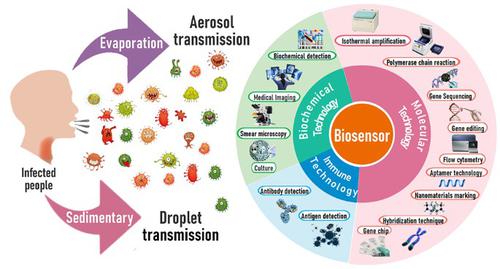Frontiers of Environmental Science & Engineering ( IF 6.4 ) Pub Date : 2021-04-05 , DOI: 10.1007/s11783-021-1420-8 Jinbiao Ma , Manman Du , Can Wang , Xinwu Xie , Hao Wang , Qian Zhang

|
Humanity has been facing the threat of a variety of infectious diseases. Airborne microorganisms can cause airborne infectious diseases, which spread rapidly and extensively, causing huge losses to human society on a global scale. In recent years, the detection technology for airborne microorganisms has developed rapidly; it can be roughly divided into biochemical, immune, and molecular technologies. However, these technologies still have some shortcomings; they are time-consuming and have low sensitivity and poor stability. Most of them need to be used in the ideal environment of a laboratory, which limits their applications. A biosensor is a device that converts biological signals into detectable signals. As an interdisciplinary field, biosensors have successfully introduced a variety of technologies for bio-detection. Given their fast analysis speed, high sensitivity, good portability, strong specificity, and low cost, biosensors have been widely used in environmental monitoring, medical research, food and agricultural safety, military medicine and other fields. In recent years, the performance of biosensors has greatly improved, becoming a promising technology for airborne microorganism detection. This review introduces the detection principle of biosensors from the three aspects of component identification, energy conversion principle, and signal amplification. It also summarizes its research and application in airborne microorganism detection. The new progress and future development trend of the biosensor detection of airborne microorganisms are analyzed.
中文翻译:

生物传感器在空气中微生物检测中的进展:关键评论
人类一直面临着各种传染病的威胁。空气传播的微生物会导致空气传播的传染病,迅速迅速地广泛传播,在全球范围内给人类社会造成巨大损失。近年来,空气中微生物的检测技术发展迅速。它可以大致分为生化,免疫和分子技术。但是,这些技术仍然存在一些缺点。它们耗时且灵敏度低且稳定性差。它们中的大多数都需要在实验室的理想环境中使用,这限制了它们的应用。生物传感器是将生物信号转换为可检测信号的设备。作为一个跨学科领域,生物传感器已经成功引入了多种生物检测技术。生物传感器具有分析速度快,灵敏度高,便携性强,特异性强,成本低等优点,已广泛应用于环境监测,医学研究,食品和农业安全,军事医学等领域。近年来,生物传感器的性能已大大提高,已成为一种用于空气中微生物检测的有前途的技术。本文从成分识别,能量转换原理和信号放大三个方面介绍了生物传感器的检测原理。还总结了其在空气中微生物检测中的研究和应用。分析了空气中微生物生物传感器检测的新进展和未来发展趋势。生物传感器已广泛应用于环境监测,医学研究,食品和农业安全,军事医学等领域。近年来,生物传感器的性能已大大提高,已成为一种用于空气中微生物检测的有前途的技术。本文从成分识别,能量转换原理和信号放大三个方面介绍了生物传感器的检测原理。还总结了其在空气中微生物检测中的研究和应用。分析了空气中微生物生物传感器检测的新进展和未来发展趋势。生物传感器已广泛应用于环境监测,医学研究,食品和农业安全,军事医学等领域。近年来,生物传感器的性能已大大提高,已成为一种用于空气中微生物检测的有前途的技术。本文从成分识别,能量转换原理和信号放大三个方面介绍了生物传感器的检测原理。还总结了其在空气中微生物检测中的研究和应用。分析了空气中微生物生物传感器检测的新进展和未来发展趋势。成为空气中微生物检测的有前途的技术。本文从成分识别,能量转换原理和信号放大三个方面介绍了生物传感器的检测原理。还总结了其在空气中微生物检测中的研究和应用。分析了空气中微生物生物传感器检测的新进展和未来发展趋势。成为空气中微生物检测的有前途的技术。本文从成分识别,能量转换原理和信号放大三个方面介绍了生物传感器的检测原理。还总结了其在空气中微生物检测中的研究和应用。分析了空气中微生物生物传感器检测的新进展和未来发展趋势。


























 京公网安备 11010802027423号
京公网安备 11010802027423号